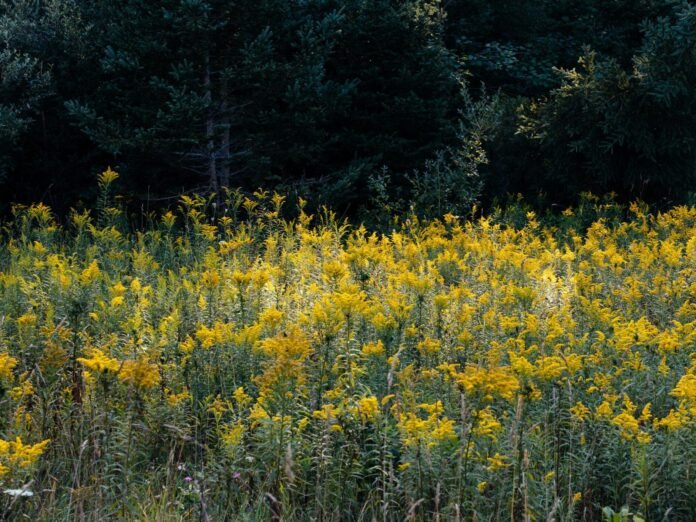Also known as: Sweet Mace, Sweet Scented Marigold, Mexican Marigold, Mexican Mint Marigold, Mexican Tarragon, Sweet Mace, and Texas Tarragon
Family: Asteraeceae
Origin: Mexico through Central America to Honduras
These plants – bearing simple (daisy-like appearing, as a child might draw), eight yellow-petaled flowers (well, not really; read on.) – are in the same genus as Asters, Chrysanthemums, Dahlias, Marigolds, and Zinnias.
The species name, Lucida, stems from the Latin word lucidus, describing glossy, shiny, or bright leaves or flowers. Their Latin genus, Tagetes, stems from Tages, an Etruscan deity, the grandson of Jupiter, who sprang from the ploughed earth . . . and all these years I thought that was just a super-startled Jackrabbit from my Kansas country youth!
This plant family has over 20,000 species and is often called Compositae because the flowers are actually a ‘composite’ of many individual flowers into one head. Hence, when children pull one ‘petal’ off at a time, saying ”she/he loves me, loves me not” they’re removing a complete flower (ray floret) with each pluck.
In Mesoamerica, the Aztecs used Anise as incense, dedicated it to the rain god, Tlāloc and mixed it in their drink, chocolatl, to add a spicy dimension. Whereas the Huichol people of Mexico have used it as an entheogen (a chemical substance that is ingested to produce a “nonordinary” state of consciousness for religious or spiritual purposes). As a talisman, it was burned as incense to ward off evil spirits – maybe we should try that for neighbors who borrow tools and never return them!
Anis was also used by the Aztecs as a tea for hiccups and diarrhea . . . not a good combination! Yet today, it is still used in Mexico to treat the common cold, as a carminative (a drug that relieves flatulence), promote lactation, and relieve rheumatic complaints.
Additionally, it has traditionally been used for digestive problems, fever, hiccups, inflammatory difficulties, malaria, pregnancy avoidance (!), scabies, and upset stomach.
In Argentina, in the form of a leaf decoction, it has been used for colic, coughs, feverish illnesses, nausea, and, when applied to the skin, as an insect repellent.
In overall perusal, evaluation, and synopsis, it is perhaps most valued for its beneficial effect on the digestive system. Of a more contemporary nature, its essential oil has shown anti-fungal activity against such as Aspergillus niger (which causes ear or lung infections) and Fusarium oxysporum (the cause of Fusarium wilt – a common and economically significant plant disease.)
Research suggests Anis may have immunomodulatory and neuroprotective properties. The leaves and whole plant are diuretic, febrifuge (fever reducer), hypotensive, narcotic, sedative, and can act as a stimulant. Its consumption depresses the central nervous system, and it is said to be anesthetic and reported to be hallucinogenic.
It is used externally to treat scorpion bites and to remove ticks (Only time will tell of its effects on tocks!
With male and female organs on each plant, they require well-drained, moderately fertile soil in a sunny location. They grow well in heavy clay and sandy soils, but are not very cold-hardy.
From a point of edibility, its flavor is similar to Parsley and Celery combined with notes of sweet, spicy curry. The flavorful leaves are dried and ground into a powder, then used as a Tarragon or Fennel substitute for soups and sauces. The dried leaves and flowering tops can be brewed into a pleasant flavored tea, a popular drink in Latin America, while the petals are used as a condiment.
And now, here are several, relevant, Nifty Nuggets of Knowledge:
Attractive to pollinators such as bees and butterflies, its blooms are rich in nectar and pollen. A natural yellow dye can be made from these blooms, and they are among the most sweetly-scented of all flowers! (Enjoyment hint: Remove dead flowers before the seeds form to extend their flowering season.)
Secretions from its roots – three or four months after sowing – have an insecticidal effect on nematodes and garden pests like Asparagus Beetles, Bean Weevils, and Keeled Slugs.
The same plant-generated chemicals have an effect against some persistent weeds, such as couch grass.
A dried plant can be burnt as an incense and to repel insects, while its powdered leaves, as well, are often used to repel or destroy mosquitoes, hen lice (of interest to poultry people primarily), and other small critters that ‘bug ya.’
Next time – when talking to your plants – inquire of your Iris, Roses, and Tulips why they can’t help you in a similar manner!


